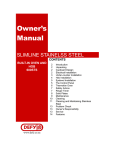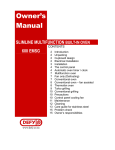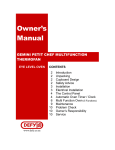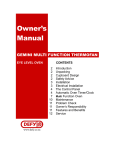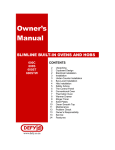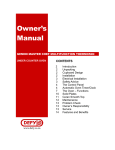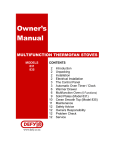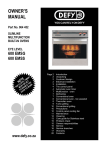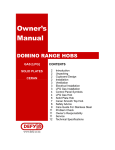Download Defy 600STE Owner`s manual
Transcript
Owner’s Manual SLIMLINE STAINLESS STEEL BUILT-IN OVEN 600 STE THERMOFAN www.defy.co.za CONTENTS 2 2 2 3 3 4 5 5 5 6 7 8 10 10 10 Unpacking Cupboard Design Electrical Installation Installation The Control Panel Thermofan Oven Turbo Grilling Ringer timer Precautions Maintenance Cleaning Care Guide for Stainless Steel Problem Check Owners Responsibilities Service INTRODUCTION Congratulations on the purchase of this quality product. We trust that you will enjoy many years of trouble free use. Please read these instructions carefully before using the oven. This manual will provide you with information on how to operate and care for your product in order that you gain the maximum benefit from it. UNPACKING • Please ensure that packaging material is disposed of in a responsible manner. • Plastic bags should be cut up to prevent children playing with them and accidentally suffocating. • Remove all packing from the oven cavity and position the accessories. • If the appliance is damaged in any way, do not use it. Report the damage to your dealer, who will take the necessary corrective action. CUPBOARD DESIGN • • • Cooking appliances generate considerable heat. The layout and materials of the mounting cabinet should take account of the characteristics of the oven. Surfaces immediately adjacent to the oven should be able to withstand temperatures of up to 100°C without delaminating or discolouring. Because the oven vents through the handle, overhanging doors above the oven may be subjected to heat as well as condensation if very moist foods are being cooked. ELECTRICAL INSTALLATION “This appliance must be earthed and the manufacturer and the seller do not accept responsibility for any damage due to incorrect installation or electrical connection.” • • This appliance should not be connected through an earth leakage system. Refer to S.A.B.S. 0147. Support the oven in front of the aperture and make the electrical connection before installing. This will ensure enough cable length for subsequent servicing. Connection to the power supply must be carried out by a licensed electrician, who will ensure that the oven is correctly connected and safely earthed. The rated current is printed on the serial number label attached to the oven side trim. The appliance must be connected to the mains through a double pole isolating switch which has a minimum clearance between the contacts of 3 mm. in both poles. A means for disconnection must be provided in the fixed wiring. INSTALLATION • • • Insert the oven into the cupboard. Open the door to expose the fixing holes in the side trims. Secure the oven by 4 countersunk screws (fasteners are not supplied). _3 60 + 0 _3 590 + 0 Aperture 590 H x 565 W x 570 D Aperture Typical section showing ventilation requirements 565 + _3 0 _3 900 + 0 Aperture Above floor level Floor THE CONTROL PANEL Ringer timer Bake / Grill Oven selector Thermostat THERMOFAN OVEN Registered by Defy in 1978, Thermofan cooking differs from conventional cooking in that it uses the principle of forced convection within the oven. The advantages are: 1. Both trays may be used at the same time. 2. Different dishes can be cooked simultaneously without flavour or aroma transfer. Hence fish, meat and cakes can be baked at the same time. 3. The oven door may be opened any time for inspection purposes without risking a flop. 4. By circulating hot air around the food, spit-roast chickens may be done without using a rotisserie. 5. Cooking is done at slightly lower temperatures (10 C TO 20 C lower), saving electricity and reducing splatter. Cooking • Set the selector to bake and the oven thermostat to the required temperature. • The indicator light will glow and remain on until the oven has reached the selected temperature. When the indicator light switches off, the food should be placed in the oven. During cooking the indicator light will cycle on and off as the oven thermostat maintains the selected temperature • After completion, return the selector and the oven thermostat to the OFF position in an anti clockwise direction. Position 4 = T/fan baking 4 3 2 1 Position 2 = T/Fan roasting / baking Position 1 = T/Fan roasting ( large) Baking guide • Thermofan baking is done with the oven trays in position. An unused tray should be kept in position to facilitate proper airflow. • For small items the entire area of each tray may be utilised. Larger items should be placed towards the front of each tray. • All ovens extract a certain amount of moisture from the food being cooked. The much greater capacity of the Thermofan oven allows more food to be cooked and thus more moisture may be released. This is normal and not detrimental to the food or the oven. • For professional results and perfect browning, open the oven door when half the baking time has lapsed. Then turn the baking tins around so that the sides previously facing the back of the oven now face the front. Caution: Thermofan baking relies on good contact between the bottom of the cake tin and the oven tray. Do not use spring form baking tins with a raised bottom. The lack of contact will cause the bottom of the cake to be underdone. These tins may be used on a wire shelf where no insulating air space is created. TURBO GRILLING • • • • • • • • The oven door must remain closed when turbo grilling. Turbo grilling is most suitable for meat, as drying out and shrinkage will be reduced Use only a wire shelf when grilling as the intense heat could warp the baking tray. Set the selector and oven thermostat to the grill positions Pre-heat the roast pan / broiler for 5 min. under the grill element to help seal the meat. Place the food on the broiler and place this on a wire shelf near to the grill element. Monitor the grilling process to avoid burning the food. After completion, the selector and thermostat must be returned to 0. 4 3 Position 3 is recommended for grilling 2 1 WARNING: ACCESSIBLE PARTS MAY BECOME HOT WHEN GRILLING. ALWAYS USE OVEN GLOVES WHEN HANDLING FOOD IN THE OVEN AND KEEP CHILDREN WELL AWAY FROM THE PRODUCT WHEN IT IS IN USE. RINGER TIMER • • • • The ringer timer may be used for timing the cooking period. It does not switch off the oven but gives an audible ring when the selected time period has elapsed. Turn the control knob to 60 minutes to wind up the mechanism. Return the knob to the desired period. When the time has elapsed, the timer will ring for a few seconds. PRECAUTIONS • • • • • • • Only use the oven for preparing food. Always keep children away from the product when it is in use. Do not leave hot fat or oil unattended. If overheating occurs, these could catch fire. Do not store flammable items in the oven. If the oven is inadvertently switched on, these could catch fire. Switch off the power at the wall switch in the event of a fault or when cleaning the appliance. Avoid spilling fruit juice, particularly citrus, on the oven as it could damage the enamel. Always keep the oven door gasket clean as this will enable the door to seal properly. MAINTENANCE Lift-off oven door • The oven door may be removed to improve access to the oven cavity and facilitate cleaning. • Open the door fully, turn the appropriate washers to lock the two hinges (see sketch) and, using both hands, lift the door out as shown. • After cleaning, refit in reverse order. Removing the inner door glass. • The glass may be removed for cleaning purposes by removing the two screws which hold it in place. • It is now possible to clean the inside of the outer glass if required. • Wash the glass in hot soapy water, rinse and dry. • Re-assemble by carefully locating the rubber seal in the embossed groove before fitting the glass. The glass is marked “THIS SIDE TOWARDS OVEN”. • Re-fit the two securing screws. Removing the side racks and shelves • The side racks and shelves may be removed for cleaning purposes. • Remove the bottom bake element guard. • Slide the shelves and bake trays out fully against the shelf stop. • Lift the front slightly and slide it out • The side racks may be removed by pulling the retainer rod slightly downwards thereby dislodging it from the retainer lug at the bottom centre. Lift the racks free of the retaining slots in the oven wall. • Replace in reverse order. MAINTENANCE continued Oven light The oven light is switched on by the selector switch and switches off when the knob is returned to 0. To replace a faulty light bulb, proceed as follows. • Switch off the power at the wall switch to avoid the possibility of electric shock. • Remove the light cover by unscrewing it in an anti-clockwise direction • Unscrew the faulty bulb and fit a new 25 watt bulb rated for 300°C • Refit the light cover. CLEANING Cleaning the oven • Switch off the electrical power supply before cleaning any part of the appliance. • Open the oven door and allow the oven to cool down. • For your convenience, the shelf, bake trays and side racks may be removed to improve access. • Clean the oven with a damp, hot soapy cloth. • It may be necessary to soak burnt soils with a liquid cleaner to soften them before scrubbing them with a nylon brush or scouring sponge. • Heavy soils on the bottom of the oven may require overnight soaking under a sponge liberally sprinkled with household ammonia. The soil can then be removed the following morning by washing normally. • Do not use metal objects or steel wool to clean the oven. General cleaning • Switch off the electrical power supply before cleaning any part of the appliance. • Wipe down glass panels, cabinet, door, control knobs, trims and handle with a hot soapy cloth. • Use only liquid household cleaners and avoid abrasive powders, scouring pads and caustic cleaners. • Rinse and wipe down with a clean cloth. CARE GUIDE FOR STAINLESS STEEL Stainless steel is not adversely affected by normal household use but because of it’s reputation for durability, it is sometimes assumed to be indestructible, and therefore subjected to misuse or even abuse. Care should be taken to avoid such ‘abnormal use’. CLEANING MATERIALS DO USE • A soft cloth or synthetic sponge. • Soap, or mild household detergent (Handy Andy) • Diluted ammonia in warm water. • A nylon bristle brush. • Cleaners labelled “Suitable for stainless steel” DO NOT USE • Acids • Coarse abrasive cleaning powders. • Metallic scourers, steel wool or metal scrapers. • Wire brushes or emery paper. • So called ‘silver cleaners’. • Kitchen scourer/foam pads CLEANING PROCEDURE • • • • Frequent cleaning is recommended rather than an occasional aggressive clean. Routine cleaning will preserve the corrosion resistance and appearance of the stainless steel for many years. Clean the stainless steel as often as necessary (ie. when noticeably dull or dirty) and use the simplest cleaning method that will effectively do the job. Use clean water, or a mild detergent solution applied with a soft cloth or sponge. Rinse well and wipe dry. ALWAYS WIPE IN THE DIRECTION OF THE BRUSHED TEXTURE ON THE STAINLESS STEEL CONDITION ACTION NOTES AND COMMENTS Requires routine cleaning Mild detergent solution If possible use warm to handapplied with soft sponge or hot water. A 5% addition of cloth. Rinse and wipe dry. ammonia is beneficial. Finger prints Pre-treat finger marks with alcohol or an organic solvent. Follow immediately with routine cleaning Minimize re-occurrence by applying a wax or silicone based household polish to the clean dry surface Wipe with a little baby oil Apply whenever necessary and a soft lint free cloth. Buff to shine. Stubborn stains and discolouration Use a little Ceran cleaning Repeat several times rather paste. (available from Defy than resorting to a single aggressive cleaning method Service Centres) Rinse and dry. Grease and fat splatter. Wipe off excess with a soft cloth or paper towel. Use a water borne degreasing agent (dishwashing liquid).Follow up by routine cleaning. Scratches on the brushed finish. For slight scratches, use a Deep scratches will be nylon pad loaded with an difficult to remove iron free abrasive polishing completely. Do not use steel compound. Follow the wool or metal scourers unless direction of the original they are made from stainless texture. Follow up with steel. routine cleaning. For deep scratches use a coarser abrasive initially and follow up as for light scratches. It must be appreciated that some of the above suggested procedures will alter the surface appearance of the treated area. They should therefore only be applied with due consideration and care. PROBLEM CHECK Before calling a service technician to assist with a problem, PLEASE CHECK: THE MAINS DISTRIBUTION BOARD THE WALL SWITCH DO NOT ATTEMPT REPAIRS YOURSELF Remember that you may be charged for a service call even during the warranty period if the fault is due to or caused by any of the above. OWNER’S RESPONSIBILITY Since the following are not factory faults, they are the owner’s responsibility. • Damage to exterior finish. • Breakage of glass and other components. • Replacement of the light bulb. • Damage through improper installation or use of the appliance. • Damage caused by moving the appliance. SERVICE If you have followed the instructions and still have a problem, contact the nearest Defy Service Centre. They will be able to advise you on any aspect of the product or send a qualified technician to repair it. The Manufacturer strives for continuous improvements. For this reason, the text and illustrations in this book are subject to change without notice. Part Number 060 400











